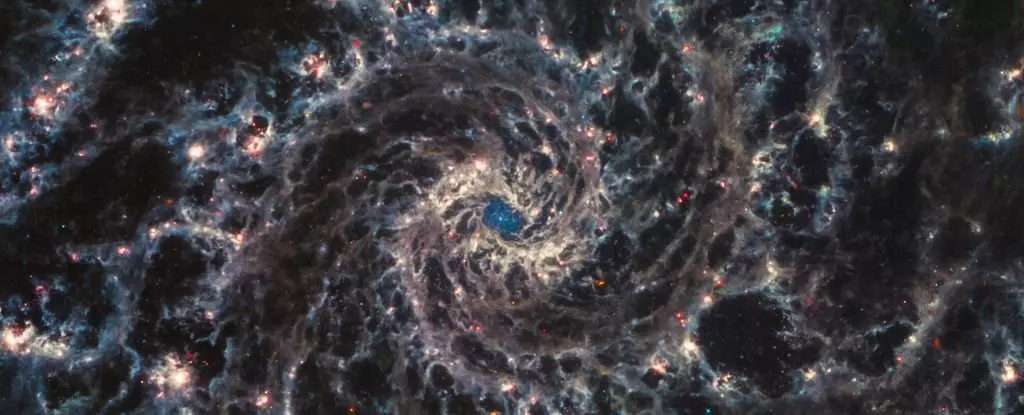The launch of the James Webb Space Telescope (JWST) on December 25, 2021, marked a monumental leap in our quest to understand the cosmos. After three decades of meticulous planning and technological advancements, this unparalleled instrument has already begun to unravel some of the most profound enigmas related to the origins of stars, galaxies, and potentially life itself.
The JWST’s capacity to observe the universe is revolutionizing astronomy. Unlike its predecessor, the Hubble Space Telescope, JWST is strategically positioned beyond Earth’s atmosphere. This unique vantage point allows it to utilize infrared light effectively, sidestepping atmospheric interference and unveiling a clearer view of cosmic phenomena. Over the past three years, this state-of-the-art telescope has extended our observational reach further into the universe’s past than ever imagined.
One of its most gripping achievements has been the identification of galaxies dating back to a mere 300 million years after the Big Bang. The implications are staggering. These galaxies formed a staggering 400 million times the mass of our sun within that brief period, suggesting an exceptionally rapid rate of star formation during the universe’s infancy. This finding prompts further investigation into the mechanisms behind such efficiency in star production.
Perhaps the most puzzling discovery has been the striking properties of these early galaxies. Contrary to expectations, JWST has detected them to be astonishingly bright and devoid of dust, presenting a stark contrast to the currently accepted models of galaxy formation. Traditional theories posit that galaxies accumulate dust from stellar explosions, which conversely absorbs blue light, rendering them red in appearance. Yet these early cosmic objects emit a vibrant blue light, leaving astronomers questioning the behavior of stars in the nascent universe.
Some hypotheses suggest that these early stars might have been so massive that they collapsed into black holes without going through the typical supernova phase. Others propose that immense explosions could have expelled dust far from the galaxies. Meanwhile, some astrophysicists speculate that intense radiation from exotic early stars might have obliterated any dust that was present. The JWST’s revelations indicate that our understanding of early stellar evolution and galaxy formation is far from complete.
Moreover, JWST has been pivotal in analyzing the chemical compositions of these ancient galaxies, revealing unusually high levels of nitrogen coupled with lower quantities of other metals. This anomaly suggests that unique processes during the early universe may have played a role in their formation, processes we have yet to fully comprehend. The telescope challenges the existing frameworks that detail how stars interact and evolve chemically, leaving scientists with a pressing need to revisit and revise theoretical models regarding early cosmic chemistry.
Another compelling outcome of JWST’s observations is the discovery of numerous faint galaxies that have defied earlier predictions. With its advanced imaging capabilities, JWST utilized massive galaxy clusters as natural telescopes, revealing galaxies that were emitting far more energetic photons than anticipated. These faint objects might hold the key to understanding the end of the “cosmic dark ages” shortly after the Big Bang. Their potential to illuminate the processes that led to galaxy formation and evolution has opened a new avenue of exploration.
In addition to revealing vibrant galaxies, JWST has uncovered enigmatic “little red dots” throughout the universe. Initially misconstrued as supermassive galaxies, further observations have illuminated their contradictory characteristics, hinting at a complex relationship between stellar populations and potential supermassive black holes at their cores.
JWST has also identified relics of previously discovered massive galaxies that seemingly contradict current models of galaxy formation. These ancient galactic remains suggest an unexpectedly rapid accumulation of mass in the early universe, which challenges conventional paradigms. The question of whether existing models can accommodate such rapid early star formation or perhaps require a reevaluation of dark matter’s influence is sparking intense debate among cosmologists.
As the JWST forges ahead on its mission, it promises to reveal more cosmic secrets, providing us with a clearer picture of our universe’s origins. As we synthesize its findings with existing theories, we must remain open to the many ‘unknown unknowns’ waiting beyond the edges of our current knowledge. The cosmos is a vast, often inscrutable expanse, but the JWST serves as a beacon, urging us forward in our relentless pursuit of understanding, exploration, and discovery. With every observation, we are drawn closer to unraveling the cosmic tapestry that ultimately shaped our existence.

